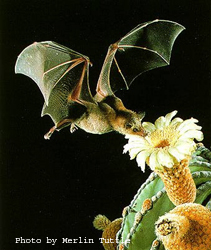Animal Fact Sheet: Lesser Long-nosed Bat |
Identifying Features Lesser long-nosed bats (Leptonycteris curasoae) are yellow-brown to gray above, with rusty brown fur on their belly. Their tails are short and their ears are large. Like all members of the leaf-nosed bat family, they have a triangular shaped noseleaf that juts from the end of their noses. |
 |
Migration/Hibernation This bat is one of only a few species that undergo a long distance migration. They do this in order to follow the flowering or fruiting cycle of their food sources; saguaro, cardon, agave and organ pipe cactus. |
Habitat Thousands of these bats will spend their day roosting in caves or mines. These sites offer general safety from predators, provide the proper temperature, are used as maternity sites, and places to rest during migration. Their outside habitat is generally considered to be desert-scrub. |
Range They are found in southern Arizona and southwestern New Mexico, western Mexico, Baja California del Sur and into Central America. |
Wild Status In 1988 these bats were listed as endangered by the U.S. Fish and Wildlife Service. Maternity roost disturbance and effects of habitat loss are the primary threats for these bats. |
Diet They only eat the fruit and nectar of night-blooming cacti including saguaro, cardon and organ pipe, as well as several agave species. |
Predators Predators such as owls, snakes and bobcats will wait at cave entrances or interiors looking for individuals who have fallen to the ground or those that they can catch in flight. |
Reproduction In the spring, already pregnant female bats will arrive in the Sonoran Desert region and form large maternity colonies in caves or mines. There they will give birth to one pup. |
Life Span Lesser long-nosed bats live approximately 20 years. |
Size These bats are medium in size weighing 0.6 to 1.0 ounces (19 to 30 gm). They are 2.5 to 3 inches (6.3-7.6 cm) long with a 14 inch (35.5 cm) wingspan. |
Extra Fun-facts
|